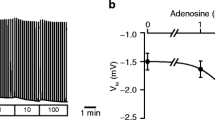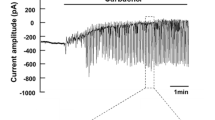Abstract
We previously reported that mouse parotid acinar cells display anion conductance (I ATPCl) when stimulated by external ATP in Na+-free extracellular solutions. It has been suggested that the P2X7 receptor channel (P2X7R) might underlie I ATPCl. In this work we show that I ATPCl can be activated by ATP, ADP, AMP-PNP, ATPγS and CTP. This is consistent with the nucleotide sensitivity of P2X7R. Accordingly, acinar cells isolated from P2X 7 R −/− mice lacked I ATPCl. Experiments with P2X7R heterologously expressed resulted in ATP-activated currents (I ATP-P2X7) partially carried by anions. In Na+-free solutions, I ATP-P2X7 had an apparent anion permeability sequence of SCN− > I− ≅ NO −3 > Br− > Cl− > acetate, comparable to that reported for I ATPCl under the same conditions. However, in the presence of physiologically relevant concentrations of external Na+, the Cl− permeability of I ATP-P2X7 was negligible, although permeation of Br− or SCN− was clearly resolved. Relative anion permeabilities were not modified by addition of 1 mm carbenoxolone, a blocker of Pannexin-1. Moreover, cibacron blue 3GA, which blocks the Na+ current activated by ATP in acinar cells but not I ATPCl, blocked I ATP-P2X7 in a dose-dependent manner when Na+ was present but failed to do so in tetraethylammonium containing solutions. Thus, our data indicate that P2X7R is fundamental for I ATPCl generation in acinar cells and that external Na+ modulates ion permeability and conductivity, as well as drug affinity, in P2X7R.






Similar content being viewed by others
References
Arreola J, Melvin JE (2003) A novel chloride conductance activated by extracellular ATP in mouse parotid acinar cells. J Physiol 547:197–208
Arreola J, Melvin JE, Begenisich T (1995) Volume-activated chloride channels in rat parotid acinar cells. J Physiol 484:677–687
Bo X, Jiang LH, Wilson HL, Kim M, Burnstock G, Surprenant A, North RA (2003) Pharmacological and biophysical properties of the human P2X5 receptor. Mol Pharmacol 63:1407–1416
Budagian V, Bulanova E, Brovko L, Orinska Z, Fayad R, Paus R, Bulfone-Paus S (2003) Signaling through P2X7 receptor in human T cells involves p56lck, MAP kinases, and transcription factors AP-1 and NF-kappa B. J Biol Chem 278:1549–1560
Burnstock G (2007) Physiology and pathophysiology of purinergic neurotransmission. Physiol Rev 87:659–797
Coutinho-Silva R, Persechini PM (1997) P2Z purinoceptor-associated pores induced by extracellular ATP in macrophages and J774 cells. Am J Physiol 273:C1793–C1800
Di Virgilio F, Chiozzi P, Ferrari D, Falzoni S, Sanz JM, Morelli A, Torboli M, Bolognesi G, Baricordi OR (2001) Nucleotide receptors: an emerging family of regulatory molecules in blood cells. Blood 97:587–600
Duan S, Anderson CM, Keung EC, Chen Y, Swanson RA (2003) P2X7 receptor-mediated release of excitatory amino acids from astrocytes. J Neurosci 23:1320–1328
Egan TM, Samways DSK, Li Z (2006) Biophysics of P2X receptors. Pfluegers Arch 452:501–512
El-Moatassim C, Mani J, Dornand J (1990) Extracellular ATP−4 permeabilizes thymocytes not only to cations but also to low-molecular-weight solutes. Eur J Pharmacol 181:111–118
Evans RL, Bell SM, Schultheis PJ, Shull GE, Melvin JE (1999) Targeted disruption of the Nhe1 gene prevents muscarinic agonist-induced up-regulation of Na+/H+ exchange in mouse parotid acinar cells. J Biol Chem 274:29025–29030
Ferrari D, Stroh C, Schulze-Osthoff K (1999) P2X7/P2Z purinoreceptor-mediated activation of transcription factor NFAT in microglial cells. J Biol Chem 274:13205–13210
Fukushi Y (1999) Heterologous desensitization of muscarinic receptors by P2Z purinoceptors in rat parotid acinar cells. Eur J Pharmacol 364:55–64
Hamill OP, Marty A, Neher E, Sakman B, Sigworth F (1981) Improved patch-clamp techniques for high-resolution current recording from cells and cell-free membrane patches. Pfluegers Arch 391:85–100
Hayashi T, Kawakami M, Sasaki S, Katsumata T, Mori H, Yoshida H, Nakahari T (2005) ATP regulation of ciliary beat frequency in rat tracheal and distal airway epithelium. Exp Physiol 90:535–544
Henz SL, Ribeiro CG, Rosa A, Chiarelli RA, Casali EA, Sarkis JJ (2006) Kinetic characterization of ATP diphosphohydrolase and 5′-nucleotidase activities in cells cultured from submandibular salivary glands of rats. Cell Biol Int 30:214–220
Hernandez-Carballo CY, Perez-Cornejo P, Arreola J (2003) Regulation of volume-sensitive chloride channels by H+ and Cl− ions in HEK 293 cells. J Gen Physiol 122:31a
Hille B (2001) Ion channels of excitable membranes. Sinauer Associates, Sunderland, MA
Hugel S, Schlichter R (2000) Presynaptic P2X receptors facilitate inhibitory GABAergic transmission between cultured rat spinal cord dorsal horn neurons. J Neurosci 20:2121–2130
Hume RI, Thomas SA (1988) Multiple actions of adenosine 5′-triphosphate on chick skeletal muscle. J Physiol 406:503–524
Idzko M, Dichmann S, Panther E, Ferrari D, Herouy Y, Virchow C Jr, Luttmann W, Di Virgilio F, Norgauer J (2001) Functional characterization of P2Y and P2X receptors in human eosinophils. J Cell Physiol 188:329–336
Inoue K, Denda M, Tozaki H, Fujishita K, Koizumi S, Inoue K (2005) Characterization of multiple P2X receptors in cultured normal human epidermal keratinocytes. J Invest Dermatol 124:756–763
Jiang LH, Rassendren F, Mackenzie A, Zhang YH, Surprenant A, North RA (2005) N-Methyl-d-glucamine and propidium dyes utilize different permeation pathways at rat P2X7 receptors. Am J Physiol 289:C1295–C1302
Kim M, Jiang LH, Wilson HL, North RA, Surprenant A (2001) Proteomic and functional evidence for a P2X7 receptor signaling complex. EMBO J 20:6347–6358
Lambrecht G (2000) Agonists and antagonists acting at P2X receptors: selectivity profiles and functional implications. Naunyn Schmiedebergs Arch Pharmacol 362:340–350
Leipziger J (2003) Control of epithelial transport via luminal P2 receptors. Am J Physiol 284:F419–F432
Li Q, Luo X, Zeng W, Muallem S (2003) Cell-specific behavior of P2X7 receptors in mouse parotid acinar and duct cells. J Biol Chem 278:47554–47561
Li Q, Luo X, Muallem S (2005) Regulation of the P2X7 receptor permeability to large molecules by extracellular Cl− and Na+. J Biol Chem 280:26922–26927
Locovei S, Scemes E, Qiu F, Spray DC, Dahl G (2007) Pannexin1 is part of the pore forming unit of the P2X(7) receptor death complex. FEBS Lett 581:483–488
Ma W, Korngreen A, Weil S, Cohen EB, Priel A, Kuzin L, Silberberg SD (2006) Pore properties and pharmacological features of the P2X receptor channel in airway ciliated cells. J Physiol 571(Pt 3):503–517
McMillan MK, Soltoff SP, Cantley LC, Rudel RA, Talamo BR (1993) Two distinct cytosolic calcium responses to extracellular ATP in rat parotid acinar cells. Br J Pharmacol 108:453–461
Melvin JE, Yule D, Shuttleworth TJ, Begenisich T (2005) Regulation of fluid and electrolyte secretion in salivary gland cells. Annu Rev Physiol 67:445–469
North RA (2002) Molecular physiology of P2X receptors. Physiol Rev 82:1013–1067
North RA, Barnard EA (1997) Nucleotide receptors. Curr Opin Neurobiol 7:346–357
Panenka W, Jijon H, Herx LM, Armstrong JN, Feighan D, Wei T, Yong VW, Ransohoff RM, MacVicar BA (2001) P2X7-like receptor activation in astrocytes increases chemokine monocyte chemoattractant protein-1 expression via mitogen-activated protein kinase. J Neurosci 21:7135–7142
Pelegrin P, Surprenant A (2006) Pannexin-1 mediates large pore formation and interleukin-1beta release by the ATP-gated P2X7 receptor. EMBO J 25:5071–5082
Pérez-Cornejo P, Arreola J (2004) Regulation of Ca2+-activated chloride channels by cAMP and CFTR in parotid acinar cells. Biochem Biophys Res Commun 316:612–617
Persechini PM, Bisaggio RC, Alves-Neto JL, Coutinho-Silva R (1998) Extracellular ATP in the lymphohematopoietic system: P2Z purinoceptors and membrane permeabilization. Braz J Med Biol Res 31:25–34
Plested AJR, Mayer ML (2007) Structure and mechanism of kainate receptor modulation by anions. Neuron 53:829–841
Plested AJ, Vijayan R, Biggin PC, Mayer ML (2008) Molecular basis of kainate receptor modulation by sodium. Neuron 58:720–735
Ralevic V, Burnstock G (1998) Receptors for purines and pyrimidines. Pharmacol Rev 50:413–492
Roman RM, Fitz JG (1999) Emerging roles of purinergic signaling in gastrointestinal epithelial secretion and hepatobiliary function. Gastroenterology 116:964–979
Ruppelt A, Ma W, Borchardt K, Silberberg SD, Soto F (2001) Genomic structure, developmental distribution and functional properties of the chicken P2X5 receptor. J Neurochem 77:1256–1265
Schwiebert EM, Zsembery A (2003) Extracellular ATP as a signaling molecule for epithelial cells. Biochim Biophys Acta 1615:7–32
Solini A, Chiozzi P, Morelli A, Fellin R, Di Virgilio F (1999) Human primary fibroblasts in vitro express a purinergic P2X7 receptor coupled to ion fluxes, microvesicle formation and IL-6 release. J Cell Sci 112:297–305
Solle M, Labasi J, Perregaux DG, Stam E, Petrushova N, Koller BH, Griffiths RJ, Gabel CA (2001) Altered cytokine production in mice lacking P2X7 receptors. J Biol Chem 276:125–132
Steinberg TH, Newman AS, Swanson JA, Silverstein SC (1987) ATP4- permeabilizes the plasma membrane of mouse macrophages to fluorescent dyes. J Biol Chem 262:8884–8888
Tenneti L, Gibbons SJ, Talamo BR (1998) Expression and trans-synaptic regulation of P2X4 and P2z receptors for extracellular ATP in parotid acinar cells. J Biol Chem 273:26799–26808
Thomas SA, Hume RI (1990) Permeation of both cations and anions through a single class of ATP-activated ion channels in developing chick skeletal muscle. J Gen Physiol 95:569–590
Turner JT, London LA, Gibbons SJ, Talamo BR (1999) Salivary gland P2 nucleotide receptors. Crit Rev Oral Biol Med 10:210–224
Virginio C, MacKenzie A, North RA, Surprenant A (1999) Kinetics of cell lysis, dye uptake and permeability changes in cells expressing the rat P2X7 receptor. J Physiol 519:335–346
Zeng W, Lee MG, Yan M, Diaz J, Benjamin I, Marino CR, Kopito R, Freedman S, Cotton C, Muallem S, Thomas P (1997) Immuno and functional characterization of CFTR in submandibular and pancreatic acinar and duct cells. Am J Physiol 273:C442–C455
Acknowledgements
We thank Laurie Koek, Jennifer Scantlin, Mark Wagner and Monica Reyna for technical assistance. We also thank Dr. Ted Begenisich for critical reading and comments on this work. This work was supported in part by grants from the National Institutes of Health (DE09692 and DE13539 to J. E. M.), (PO1-HL18208 to RE Waugh), and from CONACyT, Mexico (42561 to J. A.).
Author information
Authors and Affiliations
Corresponding author
Rights and permissions
About this article
Cite this article
Reyes, J.P., Pérez-Cornejo, P., Hernández-Carballo, C.Y. et al. Na+ Modulates Anion Permeation and Block of P2X7 Receptors from Mouse Parotid Glands. J Membrane Biol 223, 73–85 (2008). https://doi.org/10.1007/s00232-008-9115-7
Received:
Accepted:
Published:
Issue Date:
DOI: https://doi.org/10.1007/s00232-008-9115-7




